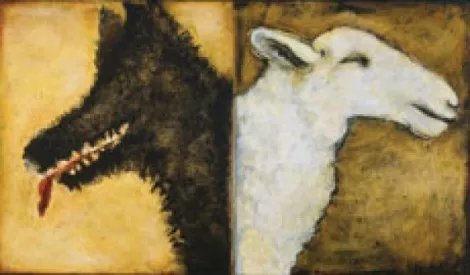
Drawing primarily from pre-Renaissance sources, this new work attempts to make a connection between the anxieties of earlier times and the fearfulness of our own period. “My versions of hell include some contemporary references,” Ure says. But not all of the views are dark; some paintings try to imagine Eden, or paradises of one sort or another.
While most of her references are European, she notes that influences from recent travels in India can be seen here. “I can see myself moving back and forth—now pessimistic, now optimistic, hoping for peace, for some way out of this firestorm of our own creation.” “The River of Heaven (The Ganges)” most directly epitomizes the paradoxical coexistence of the religious extremes of heaven and hell, with its wheel of fire hovering above tempestuous yet soothing waters.
Ure is married to Episcopal priest Father Lincoln Ure, and her Irish Catholic parochial school background can be seen as an important influence. “The rich stories of Eden, of Judgment, stories of the Apocalypse here underlie my version of our own time in history,” she says, from political strife and climate change to technological stress in the form of robots in “Age of the Machine.” By way of contrast, the paintings of Josanne Glass, exhibited in the adjacent room, are much more personal and intimate.
Ure’s agenda for the exhibit was also more ambitious than in previous shows. As Shawn Rossiter did in last year’s large pastel drawing “Tiamat,” she tried to use the virtually uninterrupted perimeter wall of the larger room in the Art Barn’s main floor to create a kind of narrative flow from one piece to the next. But it’s a narrative that doesn’t reduce to an easy “statement,” with history, geography and theology all part of each other’s thematic arcs.
In addition to the conceptual brilliance of the exhibit, Ure’s sheer command of technique is astounding. The detail of both foreground beasts and background landscapes recalls medieval illuminated manuscripts, and the wooden boards are weathered with stippled brushstrokes seemingly intended to impart the appearance of aging, as though they actually date back to the centuries that they depict.
This comes as no surprise given her background. Ure completed a Bachlor’s in painting at the University of Utah in 1979 and has been teaching there practically ever since, reaching the position of assistant professor lecturer several years ago. A university grant helped underwrite her visual diary of India “The Sightseer.” Her academic background imparts her work with an uncommon visual intelligence.
A number of pieces are presented in pairs, like the show’s title piece, a “split screen” containing wolf and sheep: polar opposites, absolute strangers, yet also hinting at a postmodern questioning of the nature of the “other.” This show plays upon various visions of the archaic, but also speaks powerfully to a present—seeming to write the history of the future with lightning-fast electronic strokes—that is deeply predicated on the past.
The momentum of this show seems to be carrying beyond this exhibit. “I started a new sketchbook the day after I delivered the Finch show,” says Ure. “Travel will undoubtedly continue to have a profound influence on my image-making.” And it‘s no surprise to find that she is drawn back to a spiritual touchstone: “I need to figure out how to get back to India.
MAUREEN O’HARA URE: STRANGER AND STRANGER, Through Dec. 28, Finch Lane Gallery, Art Barn, 54 Finch Lane, 596-5000